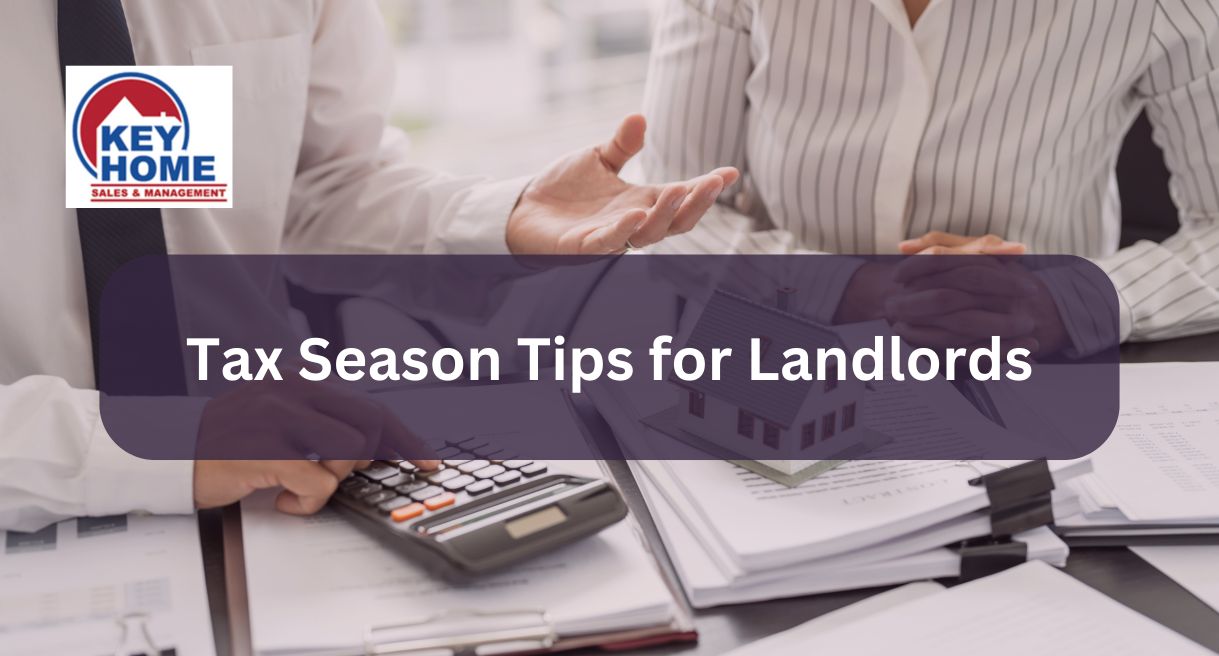Key Takeaways
Maintain Organized Records: Keep detailed financial and rental records year-round to make tax filing faster, easier, and more accurate.
Maximize Your Deductions: Take advantage of allowable deductions such as repairs, utilities, and depreciation to reduce your taxable income.
Plan for Estimated Taxes: Plan for estimated tax payments and stay compliant with both state and federal filing requirements.
Tax season is one of the most important times of year for landlords. Working with property management experts like Key Home Sales & Management helps ensure taxes are filed correctly and deductions are maximized.
This article offers a comprehensive overview of tax considerations to guide landlords, highlighting practical tips and methods to simplify the filing process, maintain financial efficiency, and minimize tax liability.
Reach Out Today!
1. Know What Rental Income Means
Having a clear understanding of what qualifies as rental income is the foundation of any landlord’s tax return. According to the Internal Revenue Service (IRS), rental income includes the following:
- Monthly rent payments collected from tenants
- Advance rents collected before the rental period
- Lease cancellation fees that renters pay
- Tenant-paid expenses, such as repairs or utilities, if tenants are not refunded
- Security deposits withheld to cover unpaid rent or damages
When filing federal taxes, it is mandatory to report all rental income on Schedule E (Supplementary Income and Loss).
Non-taxable income includes security deposits that are returned or refunded to renters. Also, rent deposits held for future use are not reported until the period arrives.
2. Keep Accurate Financial Records
Effective tax management requires detailed record-keeping. The IRS advises landlords to track all income and expenses, including:

- Lease agreements and correspondence with renters
- Mileage logs for property-related travel
- Bank statements and credit card records
- Invoices from property management companies and contractors
- Receipts for supplies, maintenance, and repairs
You can keep these records digitally by using property management software or accounting tools. Doing so will simplify the organization process and allow for easy access to financial records when filing returns.
According to IRS recommendations, all tax-related records should be kept for at least three years after filing them. However, you can benefit from keeping these documents for a longer time, especially when you own long-term assets or depreciation is involved.
3. Track Deductible Expenses
Rental property owners can deduct many expenses to reduce taxable income. Some common deductible expenses you may consider include:
- Property taxes: This is deducted as a necessary expense for property ownership
- Repairs and maintenance: Expenses for repairing roofs, fixing leaky pipes, replacing appliances, or painting.
- Advertisement: Expenses associated with marketing the rental property
- Mortgage interest: Interest paid on loans that were collected to buy or renovate the property
- Insurance premiums: Coverage for landlord policies, liability, and rental property
- Travel and mileage: Transportation for property inspections, maintenance, tenant meetings, and other activities concerning the property management.
- Property management fees: Payments to property management companies
- Utilities: If it was paid by the landlord and not the tenant
- Legal and professional services: Fees paid to attorneys, accountants, or real estate agents

Here, it is essential to differentiate expenses made for repairs and those for capital improvements. During repairs, the item is restored to its original condition, and the expenses are deducted in the same year it was incurred.
However, improvements add more value and extend the property’s lifespan. Such expenses are depreciated over several years.
4. Understand How to Apply Depreciation
Depreciation is one of the most powerful tax tools for landlords. That is because depreciation allows landlords to deduct the cost of the building over its useful lifespan (excluding the land). For residential properties, the depreciable period is 27.5 years.
However, the depreciable period for commercial properties is 39 years. Once the property is placed in service, the depreciation begins and continues until it is no longer rented or is sold.
Depreciable items include roof replacements or HVAC systems (handled as capital improvements), appliances and furniture used in the rental property, and the building structure.
Learn More About Partnering With Us!
5. Plan for Estimated Tax Payments
Landlords are different from traditional employees, who have taxes withheld from their monthly salaries. For that reason, landlords are required to make quarterly payments to the IRS for estimated tax. These quarterly payments are due in April, June, September, and January.
If you are a landlord who expects to owe $1000 or more in taxes when filing returns should pay estimated taxes. The estimated tax payments should include State income tax, Federal income tax, and self-employment tax (where applicable).
6. Know the Difference Between Active and Passive Income

The difference between active and passive income is essential when planning for Virginia tax payments. Most rental income is considered passive and is not subject to self-employment tax. The passive income puts a limit on the ability to deduct losses unless the landlord is qualified for certain exceptions.
On the other hand, landlords who manage their rental properties actively may deduct up to $25,000 in rental losses. This will depend on their income level. If a landlord spends more than 750 hours per year to manage the rental property as a primary occupation, they’ll have greater deduction flexibility because the income and losses are considered active.
7. Handle Home Office Deductions
If you are a landlord who manages the rental property from home, you may be eligible for home office deductions. To qualify for this:
- The space should be used only and regularly for activities related to the rental property
- Deductions may include property taxes, internet, utilities, and mortgage interest.
A simplified method for this deduction, according to the IRS, is $5 per square foot (up to 300 square feet).
Bottom Line
Although tax season can be challenging for some landlords, it offers a great opportunity to those who approach it with adequate preparation, organization, and professional support.
Successful landlords partner with trusted professionals like Key Home Sales & Management to stay organized, reduce stress, and achieve better financial outcomes year after year.







